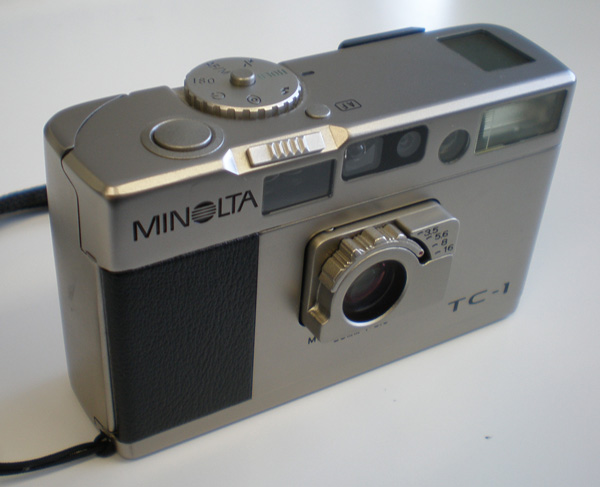
Specification, Feature, and Depiction of Minolta TC-1
(Specification and Features)
Minolta TC-1 is a compact camera released by Minolta on March 1996. The main feature of this camera is an extremely small size (99 mm x 59 mm x 29.5 mm) and an extra-high quality lens named Minolta G-ROKKOR Lens 28mm F3.5.

I met this camera when I was looking for a manul camera which was as small as possible in 1996.
Almost all compact cameras allow us to take a beautiful picture by full-auto functions, partly because they are targeted for wide-range of users. However, feelings of being made to take a picture began to get on my nurves while I was taking a picture using a full-automatic setting. All I could do was to fix a composition of a picture. I was not satisfied to follow a shuttuer speed and an aperture that the camera decided to use.
I thought that single-use cameras were better than full-automatic cameras because I could choose one among single-use cameras which were different in lenses, shutter speeds, and apertures.
Just when I was looking for a compact camera which allowed a user to decide every settings, such as shutter speed, aperture, focus, exposure, photometry, and so on, I met Minolta TC-1.
It is amazing how many functions this camera has. For example, it has a passive autofocus function with 445 steps. In dark places, it focuses automatically using automatic emission of auxiliary light. When we use a manual focus function, we can choose a distance between 22 steps. I addition, we can choose between 2 types of automatic exposure systems, that is, centre-weighted average metering and spot metering automatic exposures. These functions are very useful in elaborating degree of lightness and darkness by tuning exposure.
It is surprising that this camera has a viewfinder with a diopter adjustment system. The viewfinder is as clean as that used in high-quality SRL cameras. I enjoy just seeing landscapes through the viewfinder. In the viewfinder, we can see focused focal point and shutter speed. Therefore, we can relish the real thrill of taking a picture, that is, determining the results by tuning aperture, shutter speed, exposure values, and compositions.
In addition, a sophisticated mechanism of setting perfect-circle apertures by manipulating a lever beside the lens, which produce a beautiful background blur, stimulates a real camera fan. It is no exaggeration to say that this is a camera that will last a lifetime.
The only demerit of this camera is that it weighs 185 g. However, its catalog says that this is the smallest 135 camera (in terms of volume) in the world. I think this camera is too large to to have in my pocket. However, we have to bring a heavy SRL or range-finder camera in order to enjoy the powere of descriptions this great lens has with full manual operations. Therefore, this camera is the greatest of all light cameras.
| weight | 185g |
| size | 99mmx59mmx29.5mm |
| lens |
G-rokkor28 mm 1:3.5 5 groups 5 lens |
| aperture | perfect circle(F3.5, F5.6, F8, F16) |
| focus |
active auto-focus/ passive focus with light 455 steps |
| exposure control |
centre-weighted averaging/spot photometry |
| shutter |
program AE |
| viewfinder |
real-image viewfinder |
| flash | Built-in flash guide number 7 Flash distance 0.45-2.0m(ISO100) Auto, Red-Eye Reduction, Fill-In, Night Scene, Red-Eye Reduction Night Scene, Off |
| Power source | One 3V lithium battery (CR-123A or DL-123A) |
| Film Loading | automatic loading |
| Maker | Minolta |
| Release data | March in 1996 |
| Price | 148,000 yens |
(Depiction)
This camera produces vivid colors and clear-cut contrast.
For color films, we can get a picture like a photogravure which has darks colors and high contrast. For example, the color of autum leaves is colorful, deep, and bririant in the nortern provinces because many kinds of leaves turn red and yellow in unison. I was surprized to see a picture of autum leaves taken by TC-1 because it was unbelievabley vivid.
In addition, a monochrome picture taken by this camera has an extremely high contrast so that a casual picture seems to be like a socially aware picture which present a problem. A simple snap turns into an angry news photo. The results produced by TC-1 is in contrast to those produced by the lens of WaiWai Wide. Neither is easy to give up in creating work.
(Works by Minolta TC-1)
Minolta TC-1 Monochorome Picture Gallery1 2008.11.30
Minolta TC-1 Monochorome Picture Gallery2 2008.12.15

